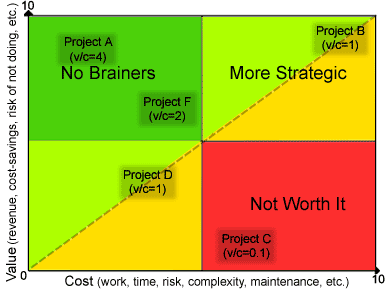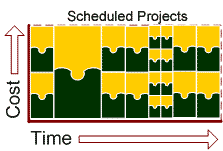Evaluation and Prioritization
Evaluation of a Project's Value
The overall value of a project is a combination of the benefits, costs, and value modifiers that are affected by that project. Effectively gauging the value of a project is key to properly prioritizing the right projects with the most positive impact to the SPU community. A project's value can be calculated by taking the benefits, and dividing it by the costs. Continue reading this article to view examples of the benefits, costs, and strategic factors that projects can have.
Benefits
The following lists just some of the criteria that can make up a project's total benefit. In most cases, some but not all of these may fit any given project.
- Revenue Increases: The project will impact revenue in a positive way. Whether it's an increase in donations or an increase in student admissions or retention, the results of this project will help increase monetary revenue.
- Cost Decreases: The project provides short or long-term cost savings to a particular department or area. The cost savings can be found in employee labor, material goods (printing, paper, etc.), or operational efficiency (fewer servers, lower travel costs, etc.).
- Student Experience: This area can be broad and covers any improvements to the student experience at SPU in academics and student life. Examples include allowing students to submit their own ID card photos or improving technology in classrooms.
- Academic Excellence: A university's mission to challenge students and help them succeed academically is positively impacted by the project.
- Time Savings: The project provides savings in the time it takes to perform repetitive tasks. Streamlining steps, speeding up processes, or automation provide time saving benefits to existing systems or processes.
Risk Mitigation: The benefits of risk mitigation may not be directly felt, but it's just as important. Risk mitigation could include increasing security, providing better emergency response services, or improving fiscal responsibility.
Costs
The following lists just some of the criteria that make up a project's total cost. In most cases, some but not all of these may fit any given project.
- Budget: The amount of money that is available for this project. The overall budget must include any monetary costs, including procurement, travel, even snacks for meetings or any hiring that must occur as a result of the project.
- Labor: The number of people who will work on this project and the amount of work that each of those people will need to do.
- Time: Several factors affect the time cost of a project. The amount of time it will take to implement the project, the timing of the project within the academic calendar, and the timing of the project related to other projects are all factors. Time is affected by or affects other cost factors like labor, complexity, budget, and risk.
- Complexity: A project's complexity will affect other costs like time, labor, and budget. It's a subset of risk - the more complex a project is, the higher the risk that other costs will increase in order to complete the project.
- Maintenance: While maintenance costs aren't part of the project's budget, it needs to be factored in as a long-term affect of the project. Any ongoing costs related to maintenance, future upgrades, and/or labor that is affected by the outcome of the project is still a cost that affects its value.
Costs can also be divided into groups; for example, listing costs by department can reveal that some departments are unable to burden the costs of a certain project. That in itself, could factor in as a risk.
Risks
A risk is something that has the potential to derail the project. The presence of risks can affect the value of a project. When they manifest, risks tend to add to the cost and can diminish some benefits of a project. Examples of possible risks include:
- Lack of commitment from key members or departments.
- Technology obsolescence; changes in technology that makes the project obsolete.
- Likelihood of losing a key project team member.
- Reliance on 3rd parties like vendors for critical work.
- "Time Crunch" risk. Factors in the project's timing, combined with the likelihood of the project needing more time. Deadlines based on external factors like the academic calendar pose a risk to a project's success.
- Assumptions can be risky. When assumptions are made about a project's details, they pose as risks with the potential of being untrue and adding costs.
Prioritization Based on Value
The overall value of a project is defined by a ratio of benefits to costs. Higher value projects will have a higher benefit-cost ratio. In the inverse, a small ratio generally means that a project has too many costs and in some cases, those projects will need to be changed and re-evaluated or cancelled. As a general rule, projects that are of higher value should be prioritized higher than a project with a lesser value proposition.
The image on the right illustrates how the value of each project can be weighed against one another to determine which projects should be tackled.
- Project A represents a high value project, with a value of 4.
- Project C represents a low value project with a value of 0.1.
- Project B and Project D are projects with neutral value, at 1.
- Project F is a project that provides value at a ratio of 2, but it's not as high as project A.
In this example, project A and F would be prioritized higher than projects B or D while project C could be placed on hold. Depending on the available resources, the projects would begin based on the priority given to them by this analysis. The outcome of this prioritization is reconciled with any existing projects in the roadmap or backlog to determine a project's place in those lists.
In some cases, the cost of a project could outweigh the benefits that completion of that project would bring. When the costs of a project far outweighs the potential benefits, then the project may not be worth doing at all. That is not to say that the benefits aren't worth it - rather that when looking at the overall impact of the project, the limited resources at hand, and the potential other projects that those resources could be used on, the project should not be done at this stage.
Value Modifiers
While simply looking at a project's value on it's own is a good start, there are other factors that can affect a project's value. These factors can have a significant impact in modifying a project's true value and should be included in every evaluation and prioritization activity. The follo
- SPU's Strategic Plan: If a project aligns with the strategic initiatives of the institution, then it could be further prioritized. Strategic alignment of a project could be a benefit. The inverse is true, where projects that work against the university's strategic plan may be de-prioritized.
- External Pressures: Common external pressures include changes in rules and regulations, the higher education environment as a whole, and more. These pressures will often force the university to take on a new project or schedule a project in a certain way.
- Operational Roadblock: Operational roadblocks can come from services that are being ended or expiring. Some projects must be taken on to prevent operational roadblocks and these projects may need to be prioritized over others. For example, when support for Banner 8 is being ended by the vendor, SPU has no other choice but to initiate a project to transition to Banner 9. The costs of the project may be high, but Banner is so crucial to the operations of SPU that the project must be done.
- Academic Innovation: Projects that advance academic innovation can be further prioritized based on the project's timing, overall labor/budget costs, and more. Academic innovation projects can also be expedited.
Proactive vs. Reactive Projects
Projects can be classified as proactive (we want to do this project because it will have X impact) or reactive (we need to do this project because of Y that will have Z impact). Reactive projects are done in response to incident(s), a change in external forces, or upcoming operational roadblocks. Depending on the timeline, reactive projects can be prioritized above proactive projects.
Project Scheduling
When projects are properly evaluated and prioritized, they can be scheduled. The schedule of projects depend on the prioritization of projects and the available resources. The image on the right represents the available resources (also known as cost) in the Y axis and time in the X axis. As projects are taken on, they take up a certain number of budget and labor resources within CIS. Most projects won't take up all of CIS's resources at any one time, so multiple projects can be worked on at the same time.
To effectively use the resources available, the ideal scenario exists when CIS is working at or near 100% capacity. Any less and we are not using our resources to its full potential. Any more and projects may be affected. There may be time when we will begin a smaller project rather than a larger, but same or slightly higher priority project in order to operate at this level.
The scheduling mentality described here applies not only to CIS, but other departments as well. We are sensitive to what departments can or cannot do when it comes to partnership in projects. No project will start unless all members of the project team have the available time and resource capacity to take it on at that time.
Project Planning
Once a project has been scheduled, implementation will commence beginning with the planning stages. Note that project prioritization will only take into account a project's value in terms of benefits, cost, and risks. Proper project planning can and will affect the outcome of a project, but failure in project planning does not affect the prioritization of a project.


